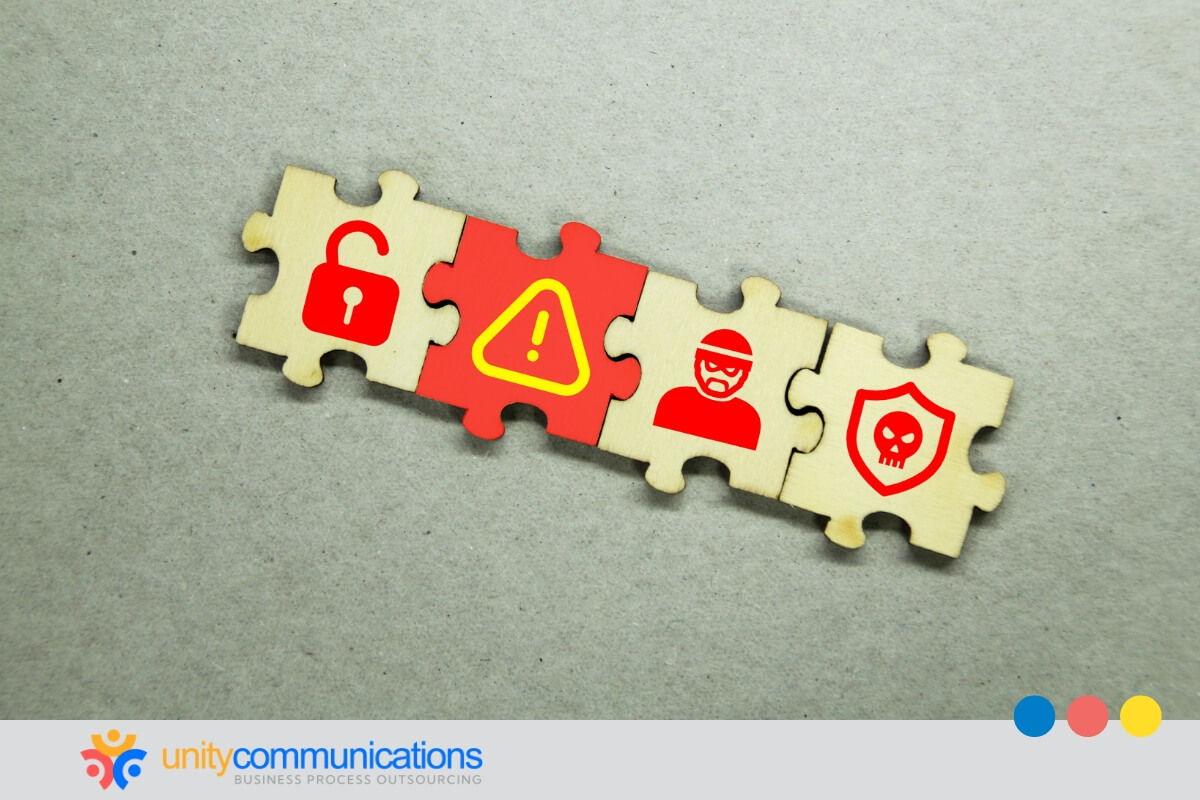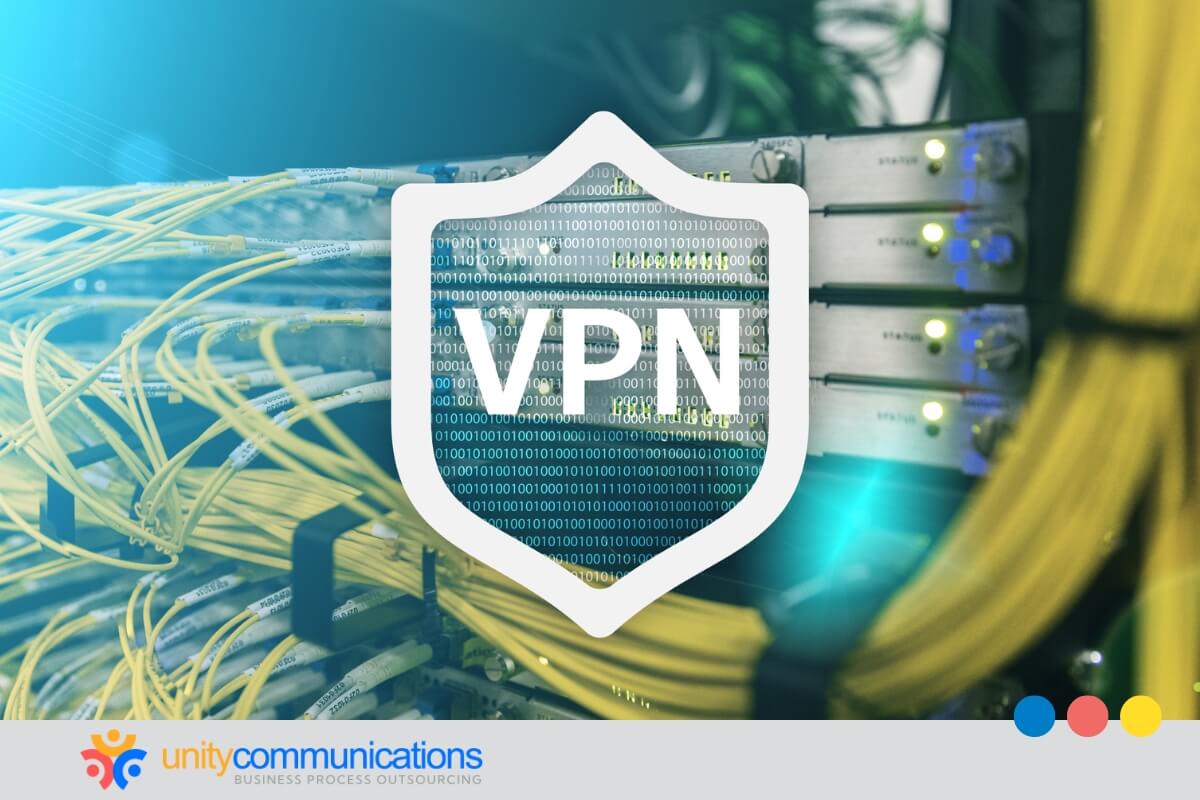Table of Contents
Business process outsourcing (BPO) has become a popular strategy for improving operations and cutting costs. However, working with third-party service providers comes with security risks.
With multiple vendors involved, the complexity increases, making it harder to identify vulnerabilities and enforce consistent security standards. The good news? Businesses can overcome these challenges through a centralized security framework that outlines clear expectations and responsibilities for all vendors.
This article explores today’s top security concerns in multi-vendor outsourcing and how to manage them effectively. Read on to strengthen your vendor security strategy.
9 critical security risks you shouldn’t ignore

Security threats are a growing concern for businesses across industries, and companies relying on multi-vendor partnerships are particularly vulnerable.
When multiple vendors handle sensitive data and business operations, the risk of security breaches increases significantly. According to SecurityScoreCard, 98% of organizations have relationships with at least one breached third party.
If you engage with third-party providers such as BPO vendors, staying informed about the most pressing cybersecurity issues in multi-vendor partnerships is critical. Understanding the most frequent and damaging security risks is the first step to building a secure multi-vendor ecosystem and minimizing risk exposure.
To stay protected, you need to identify the most common security concerns in multi-vendor outsourcing partnerships early.
1. Unauthorized access
Weak or inconsistent access controls can allow unauthorized personnel to enter systems, facilities, and sensitive data, increasing the risk of theft and operational disruption. Without proper access management, even low-level employees or external contractors can view and modify confidential information.
Physical security gaps, such as unsecured office spaces or improperly monitored access points, can further increase the likelihood of unauthorized access. Inconsistent visitor management practices and poorly maintained surveillance systems can make accessing restricted areas easier for unauthorized individuals.
2. Data breaches
Data breaches remain one of the most damaging security concerns in multi-vendor outsourcing. Poor encryption, weak security protocols, and misconfigured systems can expose sensitive information to cybercriminals, leading to financial loss.
The impact of a data breach also extends to reputation damage. You might face lawsuits, regulatory fines, and loss of customer trust. Identifying the source or vulnerability is complicated when working with multiple vendors, prolonging recovery and amplifying the consequences.
3. Phishing attacks
Phishing attacks target employees and vendors using deceptive emails, messages, or websites to extract sensitive information or login credentials. In multi-vendor environments, the interconnected nature of systems means that a successful phishing attempt against one vendor can compromise the entire network.
Once attackers gain access to sensitive information through phishing, they can use it to infiltrate other systems, steal data, or carry out more severe attacks. The rapid spread of compromised credentials or malware through interconnected systems can worsen the damage, making containment and recovery more difficult.
4. Malware and ransomware attacks
Among security concerns in multi-vendor outsourcing, malware and ransomware attacks continue to pose significant threats to multi-vendor partnerships. Malicious software can infiltrate vendor systems, disrupt business operations, and compromise sensitive data. Ransomware attacks, which involve locking critical systems and demanding payment for data recovery, have become particularly aggressive and sophisticated.
An infected system can spread quickly across interconnected networks, affecting multiple vendors and business units. Operational downtime, financial loss, and reputational harm are common consequences.
5. Man-in-the-middle attacks
Man-in-the-middle attacks occur when attackers intercept communications between vendors and clients, allowing them to steal or manipulate sensitive data. This attack compromises the integrity and confidentiality of business transactions and customer interactions, eroding trust and damaging relationships.
The increasing use of unsecured communication channels, such as public Wi-Fi and poorly configured VPNs, makes man-in-the-middle attacks easier to execute. Once attackers can access the communication stream, they can alter financial transactions, steal login credentials, and introduce malicious code into the network.
6. Distributed denial-of-service (DDoS) attacks
DDoS attacks overwhelm vendor networks with high volumes of malicious traffic, causing service outages and disrupting business operations. Attackers use botnets or other automated tools to flood servers with requests, rendering systems unresponsive and inaccessible to legitimate users.
The interconnected nature of multi-vendor partnerships means that a successful DDoS attack on one vendor can ripple across the entire network, affecting multiple business units and customer-facing systems. Prolonged downtime can lead to financial losses, missed business opportunities, and frustrated customers.
7. Structured query language (SQL) injection attacks
SQL injection attacks target vulnerabilities in web applications, allowing attackers to manipulate databases and extract or alter sensitive data. When vendors rely on poorly coded or outdated applications, attackers can exploit input fields or search queries to execute unauthorized commands.
The consequences of SQL injection attacks include data corruption, unauthorized access to confidential information, and exposure of customer records. Attackers can also modify application behavior or gain control over underlying systems, creating additional security risks.
8. Technical errors
Technical errors, such as system misconfigurations, software glitches, and employee mistakes, can create significant security gaps in multi-vendor environments. Poorly configured firewalls, outdated software, and unpatched systems increase vulnerability to external attacks and internal breaches.
The complexity of managing multiple vendors with varying technical standards increases the likelihood of configuration errors. Even small mistakes, such as granting excessive access privileges or failing to update software, can expose sensitive data and weaken overall security.
9. Insider threats
Insider threats are among the most common yet overlooked security concerns in multi-vendor outsourcing. Employees or contractors with access to sensitive data can misuse their privileges, either intentionally or accidentally, leading to data leaks or security breaches.
The involvement of multiple vendors increases the complexity of monitoring insider behavior and enforcing security policies. Differences in employee training, access protocols, and background screening practices among vendors can create inconsistencies and increase the risk of insider threats.
These security concerns in multi-vendor outsourcing partnerships have become more prominent recently. Statista states data breaches reached a record high in 2020, with nearly 125 million data sets exposed during the pandemic.
Maintaining consistent security standards across all partners is critical in a multivendor environment. Understanding the BPO’s role in addressing these security challenges is also crucial, as it involves safeguarding sensitive data and ensuring coordination and compliance among multiple BPO partners to maintain business stability.
7 proven strategies to overcome security challenges

Managing security in a multi-vendor environment requires a strategic and coordinated approach to protect sensitive information and maintain business continuity. Below are key strategies to overcome security concerns in multi-vendor outsourcing:
1. Establish clear security policies and standards
Defining and enforcing comprehensive security policies and standards is essential when working with multiple vendors. Establishing guidelines that outline data handling, access control, and incident response procedures eliminates gaps and ensures that every partner follows the same security protocols.
Standardizing security expectations holds vendors accountable and measures their performance against defined benchmarks. Clear communication of security requirements during the vendor selection helps identify partners that align with your security framework.
2. Conduct thorough vendor risk assessments
Before entering into a contract with a vendor, conduct a detailed risk assessment to evaluate the BPO company’s security. This includes reviewing the vendor’s history of data breaches, security certifications, and compliance with industry regulations.
Ongoing risk assessments are equally essential to determine whether they continue to meet security standards. Scheduling regular audits and security evaluations can identify new risks and address them promptly.
3. Implement strict access controls
Managing access to sensitive data and systems is critical in a multi-vendor environment. One tactic is role-based access control, where vendors and their employees can view and modify only the data required to perform their tasks.
Multi-factor authentication (MFA) and zero-trust policies add additional layers of security, reducing the risk of unauthorized access. Tracking and logging access activity also helps quickly identify and respond to suspicious behavior.
4. Transmit and store data securely
Securely transmitting and storing sensitive information is crucial when working with many third-party firms. You can require vendors to encrypt data at rest and in transit. Secure communication channels, such as virtual private networks (VPNs) and encrypted messaging platforms, can also minimize the risk of data interception.
Establishing secure data storage protocols, including regular backups and access restrictions, protects against loss and speeds up information recovery during a breach or system failure.
5. Develop a centralized incident response plan
A well-defined incident response plan hastens your response during security breaches. In a multi-vendor environment, coordinating with multiple BPO teams amid a security incident can be challenging without a centralized plan.
The incident response plan should include clear communication channels, defined roles and responsibilities, and recovery procedures. Regular incident response drills with vendors help ensure that everyone knows their part in the event of a breach, reducing recovery time and minimizing damage.
6. Monitor vendor performance and compliance
Monitoring vendor performance and compliance with security requirements is essential for maintaining a secure outsourcing environment. To streamline the process, you can automate tracking security metrics, such as system uptime, data breach attempts, and incident resolution times.
Regular security audits and performance reviews of third-party BPOs identify gaps and corrective actions before problems escalate. Setting penalties and adding termination clauses for non-compliance reinforce the importance of adhering to security standards.
7. Train employees and vendors on security best practices
Human error remains one of the leading security concerns in multi-vendor outsourcing, with nearly 40% of organizations experiencing major outages due to such mistakes. Training employees and vendors on security best practices is essential to mitigate this risk.
Security training can cover topics such as identifying phishing attempts, creating strong passwords, and handling sensitive data securely. Regular refresher courses and updates on emerging threats keep security awareness high.
Managing security in a multi-vendor outsourcing environment involves building a resilient, scalable trust system. By proactively implementing these seven proven strategies, you can reduce vulnerabilities, hold vendors accountable, and ensure seamless coordination across all third-party partners. From standardized policies and thorough risk assessments to continuous training and performance monitoring, success lies in treating security as an ongoing, shared responsibility.
The bottom line

Navigating security risks in multi-vendor outsourcing partnerships is complex but manageable with proactive planning and execution. By addressing vulnerabilities, aligning vendors to strong standards, and implementing robust security frameworks, you can protect sensitive information, maintain operational stability, and foster stakeholder trust.
Ready to secure your multi-vendor operations and drive your business forward? Let’s connect to build a resilient, scalable, and secure outsourcing strategy.




